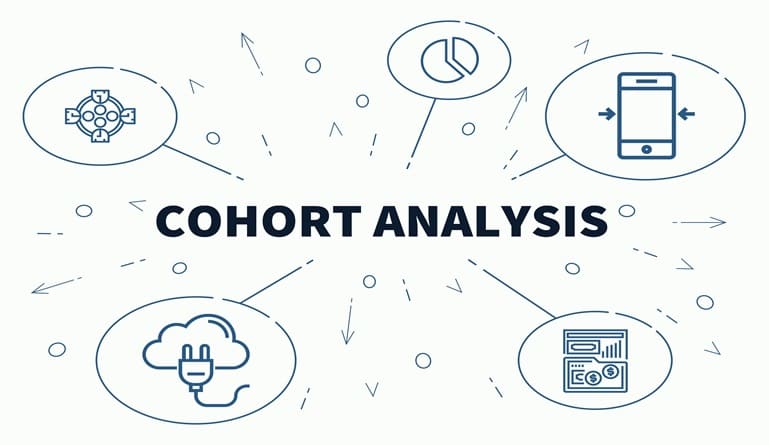Tech companies, regardless of their size or stage of growth, would greatly benefit from having a firm grasp of how their target customers behave. Understanding consumer behavior through data analysis allows prediction of future trends and promotes smarter business decision-making. Cohort analysis helps tech companies in this aspect by identifying behavioral and spending patterns based on past and current actions. This benefits companies by providing financial forecasts and means to retain and even gain customers.
Understanding Cohort Analysis
In the simplest terms, a cohort represents a segmentation of customers based on overlapping characteristics and similarities in behavior. Cohort analysis is the methodology involved in gathering that data, organizing it in a purposeful way, and discerning patterns relevant to the tech company undertaking the analysis. Within tech companies where investment towards product development and retaining customers is a significant spend, the information generated can be worth its weight in gold.
The first key step in effective cohort analysis is to determine your goal. Start by formulating the right questions in order to guide the direction of your analysis. Some common targets include understanding what channels bring your customers in, what products are preferred by particular target groups, and what features are most desired, among others. These finer goals will serve the overarching goal of managing where your finances are invested.
The second step is to decide which metrics you will use to evaluate. There are many sources of data that you can draw from. The key is to focus only on those that address your goal in undertaking cohort analysis. If you are trying to understand what channels draw your customers in the best, you want to go for backend analytics suites built into social media platforms and websites. The numbers these throw up will show you which channels work and which don’t.
The next step is to define your cohorts or identify which characteristics or behaviors will serve as categories for sorting your cohorts. These can be as general or specified as you want them to be—either of them having their own advantages. General or broad categories might give you more data but will suffer from difficulties in attribution. More specific categories might present a challenge in data collection, but you will get more reliable insights.
Finally, you need to figure out the best way to present your results so that they can be more effectively interpreted. Graphs, for example, are best suited for tracking changes in behavior over time. Charts are excellent for comparisons between sub-groups. Tables are perfect when identifying specific numbers that are crucial to the goals of your cohort analysis. It is ultimately up to you to decide. Many platforms actually do this work for you, depending on the parameters you set when you start.
Types of Cohorts in Financial Evaluation
Moving beyond the basics of cohort analysis, we now talk about the different main types of cohorts that are focused upon.
-
Acquisition Cohorts
These types of cohorts segment your customers based on their initial contact with you and their interest in what you offer. Whether defined by shorter bulks of time like the month they purchased or broader ranges like quarters in a year, these cohorts are great for analyzing both the effectiveness of your marketing pushes as well as your onboarding processes. Typically, the goal of analyzing acquisition cohorts is to determine the best time when customers are most likely to respond to your campaigns as well as the most effective channels. The benefit of analyzing this cohort mainly lies in directing your spending towards what works.
-
Behavioral Cohorts
As the name suggests, behavioral cohorts are grouped based on customer actions and reactions relative to your products or services offered. You can segment based on purchasing patterns, which features are most commonly used, and even how often a product or service is used. You can use this information to focus your efforts on improving or enhancing features that are particularly well-received or even invest in R&D into services lacking that they might be clamoring for. Additionally, you can also dial in on the actions they take when interacting with you to refine your approach to acquisition and retention.
-
Predictive Cohorts
Finally—and perhaps the most complex of these cohorts—you have predictive cohorts that leverage historical data to predict future customer action and trends. Since they are based on vast amounts of historical data, predictive cohorts are generated through advanced analytics and—lately—artificial intelligence. The patterns of predictive cohorts’ identities are valuable in making critical decisions. They also give you leeway to address serious issues before they negatively impact your business, which can help you save a lot of money.
(Also Read: Robo-Advisors: Revolutionizing Wealth Management with Automated Investment Platforms)
Cohort Analysis in Financial Evaluation: The Basics and a Case Study
A customer’s lifetime value predicts the total revenue that they will generate for your business. Knowing this lifetime value will help you better understand your customers’ average and minimum spend on your services or products. In turn, the said knowledge will help you make adjustments to your offerings to make them more appealing and sustainable in the long run.
Equally important in this discussion is the concept of churn, or the rate at which any company loses customers. This is commonly measured as the percentage of customers who stopped purchasing your products or discontinued the use of your services within a specific time period. Just keep in mind that it can get challenging to separate churn from customer lifetime value because both are intrinsically linked.
A perfect example of this would be mobile game companies like Garena, which don’t have an upfront cost to install their game on smartphones but offer near-monthly subscriptions for players to receive rewards the longer they engage and play. One of their games, Call of Duty Mobile, has recently passed US$1.5 billion in lifetime spending globally with the help of this strategy.
Interestingly, there are several ways they apply cohort analysis. Garena keeps tabs on social media chatter to gauge what changes players want in the game and sends surveys monthly to gauge which in-game items players are most willing to spend on—like cosmetic upgrades to weapons, newer items, so-called ‘legendary’ versions of characters, to name a few—and adjust accordingly.
Still, Garena will occasionally see a decline in the number of active players/subscribers due to the poor reception of a recent update. That is why, in response to this churn, they often implement a unique and exclusive reward system for players who return and even players who invite back players who have left. This is usually distributed over a period of time to keep returning players engaged.
Tying all this together is cohort analysis’ utility as a means for financial forecasting. Together with understanding lifetime value and churn, you can reasonably predict the amount of revenue to expect within a specific time period with the data you come up with.
In the example of Garena, it is clear that they utilize a deeper analysis to determine the most profitable products and highly effective updates, which in turn helps them set clear expectations for the future. This has kept their main product, Call of Duty Mobile, surprisingly resilient in the face of newer and even more polished games that have been coming out in recent months. As of 2024, it still has 73,667,979 active customers—up from just 6,196,338 players in 2021 (two years after it launched globally).
Applying Cohort Analysis to Financial Forecasting
The keys to cohort analysis’ effectivity in predicting future behavior and conducting financial forecasting lie in gathering the right data to support the cohort one is analyzing as well as applying the correct analytical models towards understanding what the data is trying to say. As long as you get both correct, the applications are limitless.
Primarily, cohort analysis is most effective in determining the trajectory of your financial growth. Evaluating the strategies that have worked in the past can help you decide which actions will help you arrive at specific goals in the future. Cohort analysis is specifically useful in that you can fine-tune your focus on specific scenarios or behaviors that you feel are most relevant.
Challenges and Best Practices
Cohort analysis is a powerful tool, but it isn’t without its challenges. For one, it requires a vast data set that can be segmented and tracked over time. It isn’t as effective if you have less data. Another challenge is that you have to be careful in the segmentation of your cohorts, metrics, and time frames so that you can choose which ones are relevant to your goals. Lastly, the process itself can consume a lot of your time and resources if you run it yourself without much experience.
If you want to do cohort analysis properly, you need to get it right from the start. Set a clear goal that you want to achieve in your cohort analysis. This will dictate how the rest of the process goes. Once you have done this, the key step is to clearly segment your cohorts based on criteria that align with your goals. From here, you also need to ensure that the personnel running the cohort analysis are well-trained and well-versed in order to get it done correctly.
Emerging Trends and Future Directions
Artificial intelligence and machine learning have been hot topics in the tech space for the past year. While they have not been fully integrated yet due to issues related to consistency and reliability, the developments and growth of AI have certainly been rapid and promising. There is a high probability that AI will play a crucial role in not just near-instantaneous data gathering but also in segmentation, analysis, and even the generation of actionable insights.
Anyone interested in leveraging cohort analysis for their tech businesses would do well to verse themselves in the development of AI and in the methodologies that govern its usage and application. It’s well and truly the future of data and analysis.
Final Thoughts
Cohort analysis is a powerful analytical tool and methodology. It allows you to leverage the wealth of data your business generates to understand consumer behavior and modify your revenue-generating strategies accordingly. It is a complex but highly scientific model that requires expertise and experience to be truly effective. So in order to fully leverage cohort analysis for your business, it is best that you read up on its intricacies.
Frequently Asked Questions
Q. How do I choose the right cohort size and time frame for my analysis?
A. The ideal cohort size and time frame depend on the study’s objectives. The cohort size should be large enough to yield significant insights while remaining manageable for analysis. As to the time frame, it should be sufficient to capture relevant patterns but not unwieldy for identifying other patterns affecting customer behavior.
Q. What features should I look for in a tool for cohort analysis?
A. The ideal tool for cohort analysis should enable you to have side-by-side cohort comparisons and a time series for tracking metrics over time. It should also enable you to create custom segments based on demographics and user behavior, among others. Additionally, the ideal tool should allow for custom reports and data visualization to help you identify patterns.
Q. What is the most likely source of issue in a cohort study?
A. Bias. Bias refers to systematic errors that lead to inaccurate estimates of the true effect of an exposure on the outcome. In cohort studies, a significant source of potential bias is loss of follow-up, which can distort results by affecting data representativeness.





